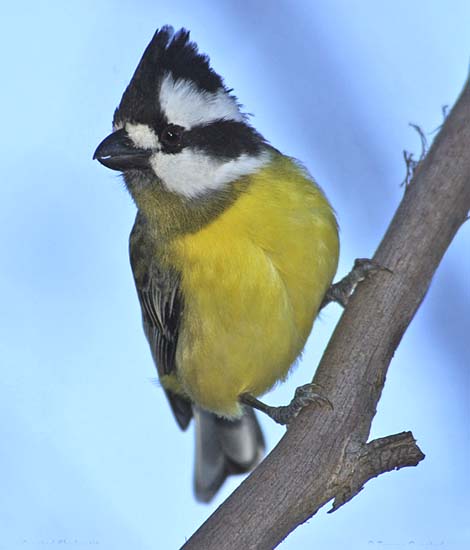
a web page by Don Roberson |
SHRIKE-TIT Falcunculidae |
|
Norman et al. (2009), using nuclear DNA, found the shrike-tit to be sister lineage to the core pachycephalids. Most global checklists then merged shrike-tit into the Whistlers (as I did several years ago). More recently, Prum et al. (2015) presented evidence that the shrike-tit's divergence from the Whistlers occurred about 22 million years ago, and thus the lineage was deemed sufficiently ancient to warrant Family status. Not
only has the family level assignment been debatable, but whether
Shrike-tit is one species (as accepted by Sibley & Monroe 1990 and
most field guides, e.g., Simpson & Day 1996, Morcombe 2000) or
three species (adopted by Schodde & Mason 1999 and Dickinson 2003)
is also an open question. The three groups differ in size, back color,
and underpart pattern. In all three, males have black throats and
females olive-green. Our headline photo is of a female. |
There had been some thought that Wattled Ploughbill Eulacestoma nigropectus was closely related to Shrike-tit. Dickinson (2003) even separated out Falcunculus and Eulacestoma as their own family Falcunculidae (Dickinson 2003). More recent molecular evidence does not support this hypothesis (Norman et al. 2009). Today the unique Ploughbill of New Guinea has been elevated to its own single-species family, the Eulacestomatidae. Although colorful, Crested Shrike-tits can be unobtrusive. Singles or small family parties forage mostly high in the canopy and can be easily overlooked unless their calls — a soft, piping, mournful whistle — are learned [Simpson & Day 1996 suggest the pneumonic 'knock-at-the-door']. Sometimes their presence is revealed by the sound of tearing bark. Morcombe (2000) writes: "The function of the heavily built, deep bill is soon apparent if one of these birds is observed foraging. Strong pieces of bark are levered up by sliding the bill under, then rotating head and body to exert a twisting force through the flat blade of the bill." In this manner hidden insects and grubs are uncovered. |
|
Photos: Trevor Quested photographed the Crested Shrike-tit Falcunculus frontatus on Mt. Wilson, New South Wales, Australia in March 2004. More fabulous photos by Trevor Quested can be seen on his website. Credited photo © Trevor Quested, and used with permission; all rights reserved. Sadly, Trevor Quested passed ahead of a rare disease in Feb 2015; there is a nice 'birder's tribute' on line on Greg Roberts' blog. Bibliographic note: There is no "family book" covering this family but the genus was illustrated and discussed in Boles (2007) and also Frith (1979). Literature cited:
|
 The Falcunculidae is a single-species family for Crested Shrike-tit
of Australia (left in a dramatic photo by Trevor Quested). It is a
distinctive bird with isolated populations frequenting open woodlands
in east, southwest, and north Australia, and has variously been
considered a whistler [family Pachycephalidae] or a member of its own
family. For a brief period some considered it a single-species family
(e.g., Dickinson 2003).
The Falcunculidae is a single-species family for Crested Shrike-tit
of Australia (left in a dramatic photo by Trevor Quested). It is a
distinctive bird with isolated populations frequenting open woodlands
in east, southwest, and north Australia, and has variously been
considered a whistler [family Pachycephalidae] or a member of its own
family. For a brief period some considered it a single-species family
(e.g., Dickinson 2003).